Not all animals have a brain, so it’s interesting to see how they function and how they manage to survive in nature. We have done a lot of research into these special species and have written all there is to know about them.
All the animals with no brain live in the water and most of them will attach themselves to a stone or the bottom of the ocean. However, this is not the case with the Jellyfish, the Starfish, and the Sea Urchins.
Let’s take a closer look at these amazing animals and see how they manage to perform basic tasks without a brain to do the thinking for them.
Table of Contents
Which animals do not have a brain?
Are actually quite a lot of animals which doesn’t have a brain.
All of them live underwater. Instead of having a brain, they have basic sensors and a simple nervous system. Let’s take a look at the animals without a brain.
Jellyfish
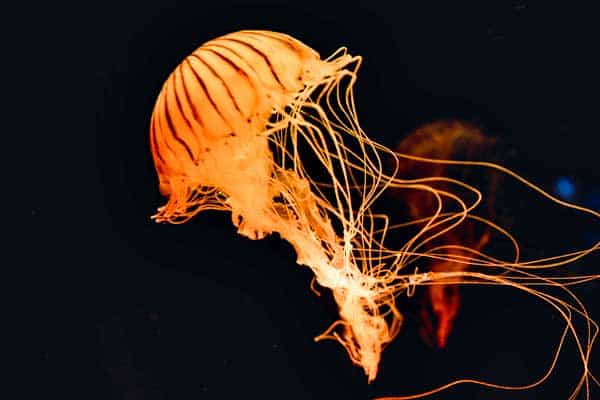
The jellyfish family tree it’s called “jellies”. Almost all the Jellys have no brain unless one specific jellyfish that’s we will see below.
The jellyfish is one of the very few animals without a brain which doesn’t sit attached to the same spot its whole life. The jellyfish is able to move around with the current in the ocean. It can also actively push itself forward by squirting out water through its mouth.
So how do the Jellyfish figure out all this stuff without a brain?
The jellyfish has a very unique network of sensory nerves. When something touches its tentacles it instantly reacts by shooting out its sting with a toxin to kill or at least neutralize an enemy. This is also why you want to avoid the Jellyfish in the water. It will not try to approach you by itself (not that intelligent), but it might sting you if you get too close.
We have written a separate article on how and what the Jellyfish eats.
A very special jellyfish is the “Comp Jelly”. It actually has a brain!
Scientists have managed to sequence the genome from the Comb Jelly, and they found some amazing facts. It’s very unique and it has a brain-like structure in its nervous system which makes it able to do rather complex tasks, even though it hasn’t got a brain.
Sea Cucumbers
These little wormlike creatures are funny. Just as most of the other animals in this article they feed on plankton floating around in the sea. They are found all over the world and they have leathery skin.
That are more than 1000 different types of sea cucumbers, and some of them have almost the same density as water. This enables them to jump up to 3,3000 feet!! (1,000 meters) and they will slowly fall back down to the bottom of the ocean.
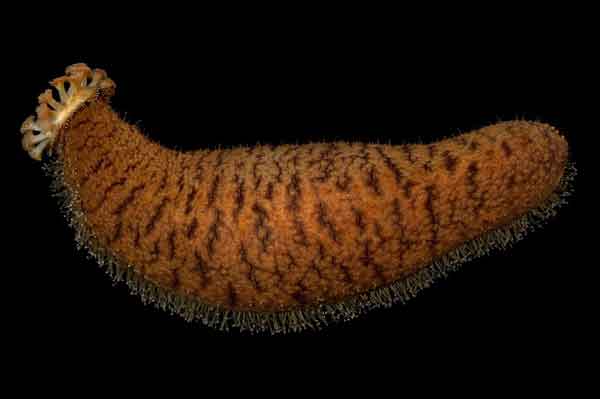
They have tiny tube-like feet around the mouth which they use to put the food into their mouth.
Corals
Just like the jellies, the corals are part of the “Cnidarians” family. They all have an asymmetric body and the ability to sting their enemies.
You might think the corals are plants they are actually real living animals. They are very simple animals, as we will see, which makes sense now that we know they haven’t got a brain.
One of the main differences between plants and animals is that plants produce their own food, while animals have to seek out food.
Corals are made up of small lots and lots of tiny animals called coral polyps. Just like the jellies, the corals eat zooplankton that swims by in the ocean. They come out at night to feed and catch the plankton with small tentacles. As soon as they catch something they pull the tentacle arm back inside and eats it.
Man O’ Wars
The Portuguese Man o’ War is probably one of the strangest animals alive.
It’s wobbly like the jellies but it has a very deadly sting! It can actually kill bigger animals and in some cases, they have also been lethal for people.
Unlike the jellies, the Man O’ Wars is named in plural form, because it’s actually not a single animal. It’s a colony of so-called “polyps” or “zooids”. They can not survive independently and they are also connected by tissue.
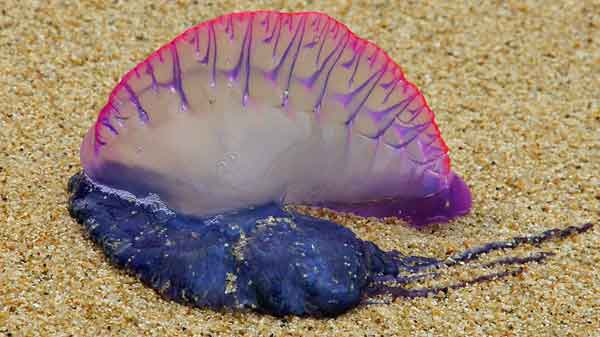
One of the only enemies of the Man O’War is the Sea Turtle. The Man O’ War is not able to penetrate the thick skin of the turtle, not even the skin on the tongue. So here the sting does no good in defending the animal.
It can quickly dive deep down when birds try to attack it by shooting gas from bladders.
Starfish
The Starfish is part of the “Echinoderms” (just like the Sea Urchins we will look at below).
They are not fish and they are not even able to swim. They have between 5 and 40 spiky arms and they basically just sit at the bottom of the ocean. Sometimes a predator will bite off an arm or two and then the Starfish is able to regenerate the lost arm.
The starfish actually has tiny eyes at the end of each arm which enables it to distinguish between light and dark. They can spot movement but not much more than that. Just enough information to stay alert of food and enemies. So again, this animal doesn’t need a brain because it has all the basic sensors it needs to stay alert.
Sea Urchins
If you have ever accidentally stepped on a sea urchin you know how spiky and pointy they are. We need to look out for these guys when you are on the beach.
However, they are not poisonous except for one species you will find in South Florida.
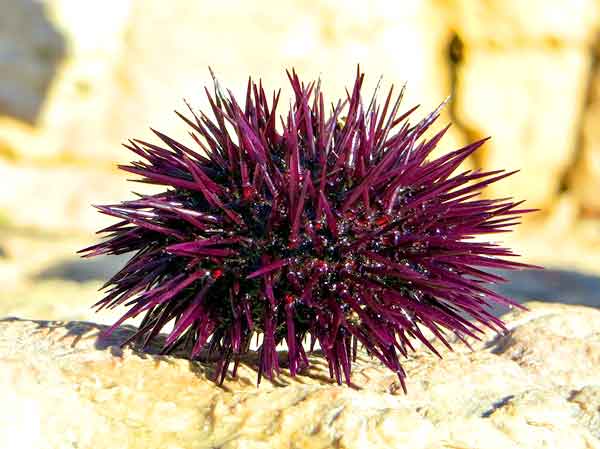
It’s amazing to see the sea urchin move around with its tons of legs. It controls the feed by what is called a water vascular system. By changing the amount of water and pressure inside the body it can move its feet.
The starfish works the same way.
They will feed while sitting on stones in the ocean and scrape them clean of algae. The mouth is located under the animal and the excrements are expelled at the top of the creature.
Sea Sponges
Another fun fact about the sea sponge is that they can actually sneeze (on the water).
Whenever something gets into their system, which shouldn’t be there, the Sea Sponge creature can take in extra water and squirt it out with a big sneeze.
This is something scientists recently found out (source) and it indicates that even though the sponge doesn’t have a brain it’s still somehow aware of its surroundings.
Here’s a video of the little guy sneezing:
Clams
Clams are part of the “bivalves” (just like the Oysters we will look at below). They all have two shells which are joined by a hinge, which means they can open an close.
Most clams do not live long but the lifespan varies from 1-500(!) years. Even without having a brain, they are able to function and move due to their rather sophisticated nervous system.
Clams actually have a beating heart, kidneys, a stomach, a mouth, and a nervous system. Maybe not the first things that come to mind when you’re eating a delicious clam for dinner.
They are really easy to catch and you’ll find them all over the world.
Oysters
Oysters are quite similar to clams. But inside the Oysters, you might find precious pearls as you might know. You have to look carefully because it’s only one in a million oysters that have the perfect pearl.
Eyster’s I want to call the filter feeder. This means they will filter the water around them and remove plankton and other organic particles in order to eat them.
This is quite similar to the way the jellyfish eats.
Our stairs can filter up to 50 gallons of water per day and that gives them enough food for quite a while.
Sea Lilys
Sea Lillies sit permanently attached to the bottom of the ocean. They look like plants with feathery arms. They are closely related to the Sea Urchins, the Starfish, And the Sea Cucumbers. It’s not too hard to believe these animals do not have a brain, right?
They can reach almost 30 inches (75 cm) and fossils show that their ancestors could be up to 80 feet (25 meters).
They have a small mouth at the center of the animal. Some species have been observed to leave their spot and float to another spot that was more suitable for eating. According to Wikipedia, they can creep along the bottom of the ocean at speeds of 140 miles per hour! (225 km/h).
As they live far down at the bottom of the ocean they will not see this daylight. So they have to rely on another energy source.
They mostly live from excrement from animals that float down towards the bottom of the ocean.
Yummy!
Sea Anemones
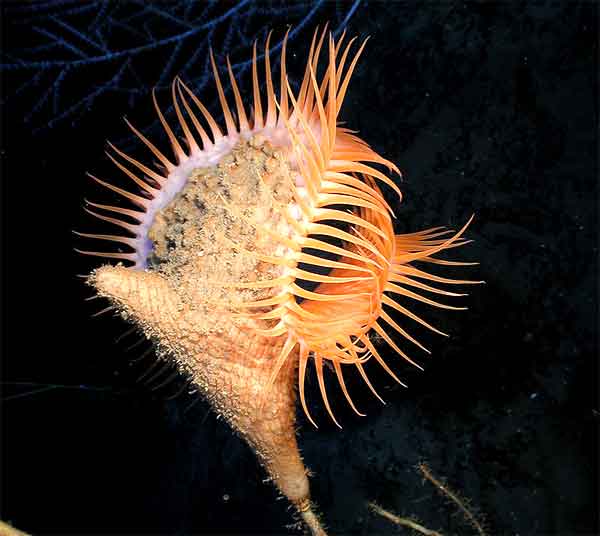
See Anemones is yet another animal that looks like a plant. But it’s very much alive and has to find food by itself. Just like the jellyfish, it has long tentacles it can use to eat.
The Sea Anemones are able to change their shape. They do so by turning and retracting a long set of muscles inside their tentacles. So they are really beautiful to watch as they sway around and change their shape and form.
So even though it does not have a brain it can react to its surroundings by sensors.
Sea Squirts
This is quarts start out as a little larva and it actually has a tiny brain.
However, in this form, the animal is not able to eat. So it will quickly find a spot to stay for the rest of its life.
As soon as it finds a good spot to settle it will start absorbing/eat its own tiny brain, and from this stage and forward it does not have a brain. This is probably one of the most peculiar transformations in the animal kingdom!
The Sea Squirt is what is a “hermaphrodite”, which means it has both male and female reproductive organs. So it does need a partner to have the kids. The little tadpole larvas will be made from eggs and sperm from the same animal.
Land animals without brains
So, all these animals are water creatures. Aren’t there any land animals without a brain?
No, we don’t believe so.
We haven’t been able to find any and if you know of a terrestial animal without a brain we’d love to hear from you. It seems that in order to function without a brain you need a simpler environment than you find on land.
In the deep sea, you can eat whatever swims by you (or you swim by) without putting any thought into that but on land, you are more dependent on hunting and surviving skills.
Why don’t these animals have brains?
The reason these animals don’t have a brain is probably that they have no need for it.
Having a brain requires a huge amount of energy. So unless you have a need for the brain it’s smarter for the body not to have one because it enables the animal to eat a lot less to stay alive.
According to the BBC, humans use 20% of our energy feeding our brain. It has a massive energy-consumption and it’s the same with animals.
Scientist suggests, that many of these animals probably had brains a long time ago but got rid of them in order to survive. Because without the brain they are able to live with much less energy which can be an advantage, especially underwater.
All the animals above are very simple creatures with few functions.
Which animals have two brains
in special circumstances animals are born with two heads or other mutations that cause anomalies like this. We also see this when siamese animals.
(And we’re not talking about the Siamese cats here, but the rare occurrences when two siblings have grown together in the womb.)
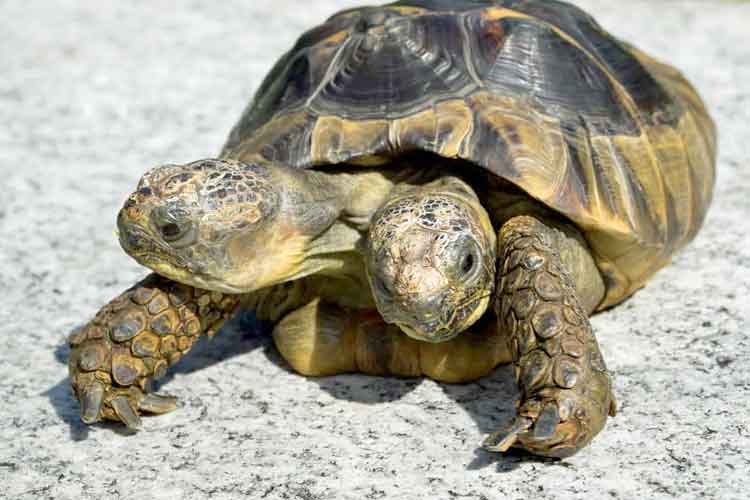
But how about animals that naturally live with two brains without it being an anomality?
No, we haven’t heard of such an animal. Some people argue that humans have two brains because the left and right parts of our brains are actually functioning separately.
They are connected by “wires” and obviously always work in close conjunction but they are actually two different pieces of meat.
Source: sciencemag.org, whoi.edu




